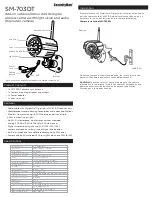H.264 Protocols & Communication Methods (continued)
Unicasting
is communication between a single sender and a single receiver over a network. This
means that the video stream is transmitted independently to each user, and each user receives
their own video stream. A benefit of unicasting is in case one stream fails, it only affects one user.
Multicasting
is bandwidth-conserving technology that reduces bandwidth usage by simultaneously
delivering a single stream of information to multiple network recipients. This technology is used
primarily on delimited networks (intranets), as each user needs an uninterrupted data flow and should
not rely on network routers.
2.7 How to Stream H.264
Deciding on the combination of protocols and methods to use depends on your viewing
requirements and on the properties of your network. Setting the preferred method(s) is done in the
control applet for AMC, which is found in the Windows Control Panel. When this has been set,
AMC will test all the selected methods in the specified order, until the first functioning one is found.
RTP+RTSP
This method (actually RTP over UDP and RTSP over TCP) should be your first
consideration for live video, especially when it is important to always have an up-todate video
stream, even if some images are lost due to network problems. This could be configured as
multicast or unicast.
Multicasting
provides the most efficient usage of bandwidth, especially when there are large
numbers of clients viewing simultaneously. Note however, that a multicast broadcast could not
pass a network router unless the router is configured to allow this. For example, it is not possible
to multicast over the Internet.
Unicasting
should be used for video-on-demand broadcasting, so that there is no video traffic
on the network until a client connects and requests the stream. However, as more and more
unicast clients get connected, the traffic on the network will increase and may cause
congestion. Although there is a maximum of 20 unicast viewers, note that all multicast users
combined count as 1 unicast viewer.
RTP/RTSP
This unicast method is RTP tunneled over RTSP. This could be used to exploit the
fact that it is relatively simple to configure firewalls to allow RTSP traffic.
RTP/RTSP/HTTP
or
RTP/RTSP/HTTPS
These two methods could also be used to traverse
firewalls. Firewalls are commonly configured to allow the HTTP protocol, allowing RTP to be
tunneled.


















